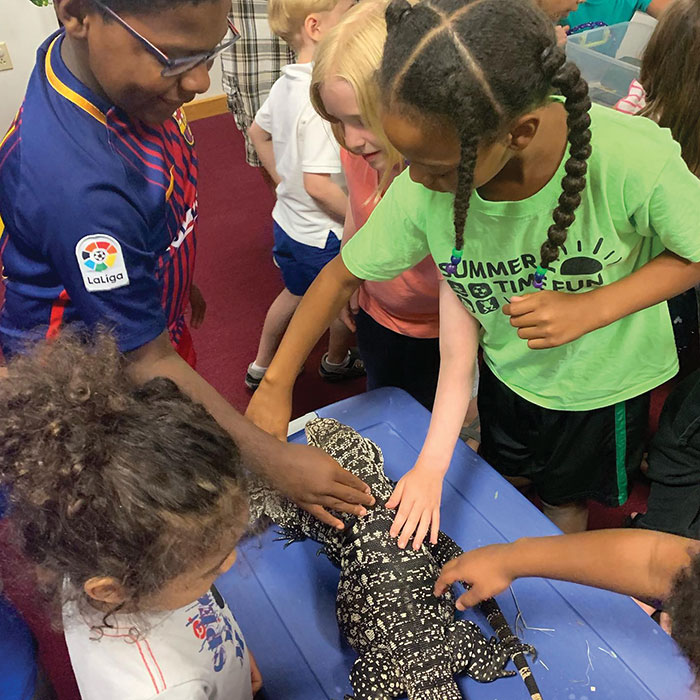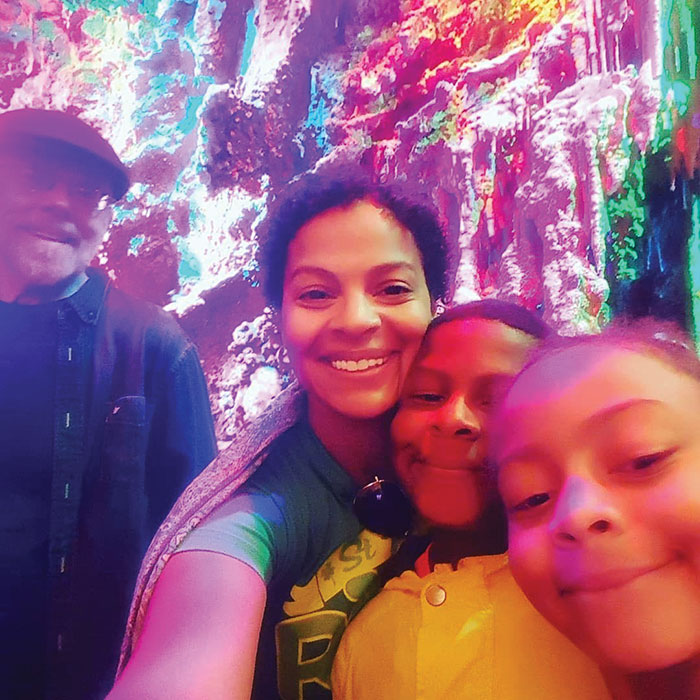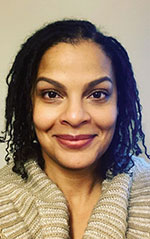Cultural Identity Formation in Third Culture Kids
Helping their children form an American cultural and national identity is a particular challenge for Foreign Service parents. One FSO offers some practical pointers from her family’s experience.
BY LIA MILLER

At a local library during a summer R&R visit to the United States, the author’s children learn about reptiles and amphibians indigenous to the American Northeast.
Courtesy of Lia Miller
Instilling a sense of cultural origin tied to a place and national identity in a family is challenging at the best of times. The constant presence of social media and globalized cultural phenomena that bombard us every second of every day promoting socially constructed notions of what and who are acceptable often bumps up against traditional cultural and national identity formation. Coupling that with raising children in the Foreign Service, a transient career where you don’t spend more than on average two to three years in each place, makes the task of helping your children form a cultural and national identity that much harder.
As someone who grew up around my extended family in small-town America, where everyone knew everyone else, where we all attended the same schools and churches, and spoke the same language, I knew who I was and where I belonged even as a young child. Fast-forwarding to now—as a mother who is raising her children in the opposite environment—I often wonder how, separated from the networks and influences that I relied on as a child, my children will know who they are and where they are from. Will they know where they belong?
The short answer is yes, they will. However, their sense of place and identity may be a little different and certainly broader than the narrow construct of “American” I grew up with. For example, my children know they are from America and that their families come from America, but America is an abstract concept for them. You see, my children have spent most of their lives overseas; and, so far, most of their formative memories have been made outside the United States. For them, “America” is a place they go to visit family and friends during the summers and holidays and sometimes both in a good year.
National Spaghetti Day brings us back to the founding fathers because, according to the lore around this holiday, Thomas Jefferson popularized pasta in the 18th century.
Their concept of “home” is wherever in the world we happen to be, and it has become more about people than a place. My children are more accurately described as “global citizens,” or third culture kids (TCKs), who are comfortable in diverse, multilingual, multiethnic environments, and who, despite their young ages, can be dropped in the middle of anywhere and will immediately dive in, adapt, and thrive.
However, for us the parents, whose roots and ties are still very America-centric, it is important that our children know this part of themselves, as well, and feel as comfortable in the United States as they do out in the world. So how do we do this with our children? For starters, we began reading books about American history and culture to our children when they were very young.
Holidays … and Other Cultural Events
We celebrated traditional American holidays in a big way and even observed some of the more modern, obscure, and wacky unofficial holidays like National Spaghetti Day on Jan. 4, National Yo-Yo Day on June 6, National Waffle Day on Aug. 24, and National Donut Day on Nov. 5, among others. While not “real” holidays, they create a space for us to have fun with the kids in a different way and to also explore the origins of the holidays we celebrate.
For example, National Spaghetti Day brings us back to the founding fathers because, according to the lore around this holiday, Thomas Jefferson popularized pasta in the 18th century. We also learned that spaghetti was introduced to broader American society by Italian immigrants in the 18th and 19th centuries. Once spaghetti was adopted into American culture, it secured its place as the popular and beloved dish it is today. This one holiday alone created an opportunity for conversations with our children about the founding fathers, the origins of diplomacy, immigration both historically and now, the evolution of American cuisine, and the contributions of immigrants to U.S. history and culture, and other topics.
During “themed” months of the year such as Black History Month, Women’s History Month, Asian American Native Hawaiian Pacific Islander (AANHPI) Month, and others, we established the tradition of incorporating into our bedtime routine stories and videos highlighting important individuals and events that are lesser known and not in most international or U.S. school curriculums. For example, during Black History Month this year, we talked about Black Wall Street in Tulsa, Oklahoma, and what happened there that brought it all to an end.
There are many interactive web-based resources that offer special perspective into different subcultures within America.
Major cultural events can also lead to identity-building educational quests. Like the rest of the world, our family fell in love with the Broadway show “Hamilton.” While the musical is a work of historical fiction, in our household it led to many conversations and long trips down internet research and fact-checking rabbit holes to learn “the truth” about the Constitution, the Continental Congress, America’s political party system, elections and the electoral college, dueling, the history and modern-day legacy of enslavement in the United States, the role of women in the nation’s founding, and many other topics.
It also led us to the amazing Hamilton Education “EduHam” program. Administered by the Gilder Lehrman Institute of American History, the EduHam program’s goal as stated on its website is “to help students see the relevance of the Founding Era by using primary sources to create a performance piece. The program consists of classroom activities and digital resources that can be incorporated into a regular curriculum on the Founding Era.” The program sparked our children’s curiosity about their home nation and “where we come from,” and through the lens of Hamilton, for the first time, my children see themselves as a part of America’s origin story.
In this lifestyle, where we spend most of our time overseas and have limited time back in the States, our family has tried to be strategic about how we use that time. For instance, in the last few years, we began dedicating a portion of our visits back to the United States to go to important historic and cultural landmarks and sites. Each winter and spring, we sit down with the kids and map out where and what they want to explore during the coming summer. Our travels have ranged from marathon visits to Smithsonian museums, a vacation by RV through some of the most beautiful national parks, and attending different types of music and cultural arts festivals. These “learning trips” are memorable for the kids because they participated in the visualization and planning of the trips, which in turn made them more invested in the experience.
There are also many interactive web-based resources available to children and teens that offer an insider’s view and special perspective into different subcultures within America (see “Online Resources,” below). For example, one of my children wants to be a veterinarian, so we spend a good amount of time on the National Geographic (NatGeo) Kids website, watching videos, playing games, and completing other engaging activities. There is a NatGeo channel on one of the streaming services we subscribe to, which means that many of our weekly family movie nights have been dedicated to watching documentaries that explore American geography, topography, Indigenous cultures, music, art, food, animals, and wildlife, and so much more. Our NatGeo movie nights always lead to interesting conversations, and my children always have a ton of questions about what they’ve seen.
Pen Pals and Online Play Dates

The author, with her father to her right and her children up front, takes a selfie in one of the main caves of Endless Caverns in the Shenandoah Valley. This stop was part of a summertime RV road trip in America.
Lia Miller
While I am not advocating spending exorbitant amounts of time online with your kids or allowing them to be online all the time, I found these resources extremely useful in helping my kids form a national and cultural identity.
However, the internet is no substitute for the real thing, which in this case is the experience of growing up immersed in one’s own culture or in a place where there are direct cultural and familial ties.
That said, as parents of TCKs, we work diligently and consciously to ensure our children maintain relationships with friends and family back in the States. We do this by encouraging our children to become pen pals with the children of friends from college, scheduling regular online play dates with friends and cousins back home, and initiating frequent conversations with grandparents, aunts and uncles, and former teammates and friends they have made when we were at home. These ties help the children feel connected to the United States and foster a sense of belonging and ownership. It also helps reduce the barriers to reentry whenever we go back home.
We hope that through these efforts—and it is an effort—our children will embrace their TCK status, and that they will thrive as global citizens. However, we are certain they will also know who they are, where they come from, and why that is important. The best part is, they will always be able to include the United States among the places they call home.
When sharing or linking to FSJ articles online, which we welcome and encourage, please be sure to cite the magazine (The Foreign Service Journal) and the month and year of publication. Please check the permissions page for further details.
Online Resources
Here are some interactive learning websites to consider by age.
Ages 4-6
- PBS Kids (pbskids.org)—Exposes children to educational stories and life lessons by a variety of authors and from our favorite children’s books including tales by Dr. Seuss, Curious George, and others that help expand children’s knowledge of new subjects.
- Smithsonian Kids (si.edu)—This site offers a variety of art, history, and cultural activities for kids/teens of all ages and starts as young as the 4-6 age range. This site offers everything at the museum network’s disposal from live video of the National Zoo to the Smithsonian Learning Lab and much more.
Ages 7-9
- Climate Kids (climatekids.nasa.gov)—This site sponsored by NASA covers a wide range of topics including weather, climate, atmosphere, water, energy, plants, animals, and more. The site talks about how we are all connected by the same ecosystem and how we must protect and preserve the climate and our world. There are numerous games, videos, and activities for children of all ages.
- Cool Kid Facts (coolkidfacts.com)—My children always love a good quote, joke, or pun; and this site offers those things in spades. This website also gives your children access to educational videos, downloadable worksheets, infographics, pictures, quizzes, and more.
- Ben’s Guide to the U.S. Government (bensguide.gpo.gov)—This interactive website takes users on various learning adventures and gives them an insider’s look at the “ins and outs” of the U.S. government. The most fun part of the experience is that Ben Franklin himself is your guide and companion.
Ages 10-13
- NASA Kid’s Club (nasa.gov/kidsclub)—This site focuses on outer space and space exploration. Kids can go on missions that will teach them firsthand what it is like to be in space.
- NGAkids (nga.gov)—The National Gallery of Arts offers older kids and tweens a unique and entertaining introduction to art and art history, much of it based on the American art medium. There is even an option for users to create works of art.
Ages 14-17
- Theta Music Trainer (trainer.thetamusic.com)—This site offers a series of online courses and games for ear training and music theory based on all musical forms and especially those that originate in the U.S. There are exercises for every level of proficiency designed to sharpen skills and move users to the next level of musicianship.
- Exploratorium (exploratorium.edu)—The Exploratorium based in San Francisco offers an online version of itself, a public learning laboratory that examines the world through science, art, and human perception.
—L.M.
Read More...
- “The Impact of Transitions on Foreign Service Families” by T. Dhyan Summers, The Foreign Service Journal, December 2012
- “What About Our Kids?” by Kim Deblauw, The Foreign Service Journal, January-February 2016
- “Raising Multilingual Children in the Foreign Service” by Nichole Schaeffer-McDaniel and Jennifer Kirk Dinoia, The Foreign Service Journal, December 2017
- “Supporting Families and Third-Culture Kids Through FS Transitions” by Wyokemia Joyner and Sarah Genton, The Foreign Service Journal, July/August 2022




